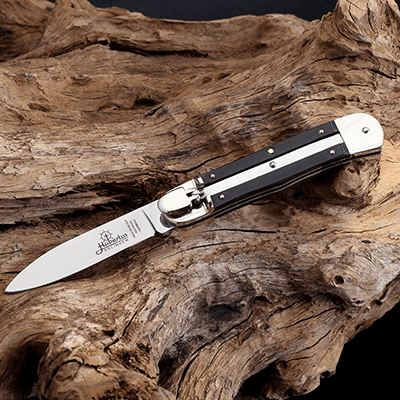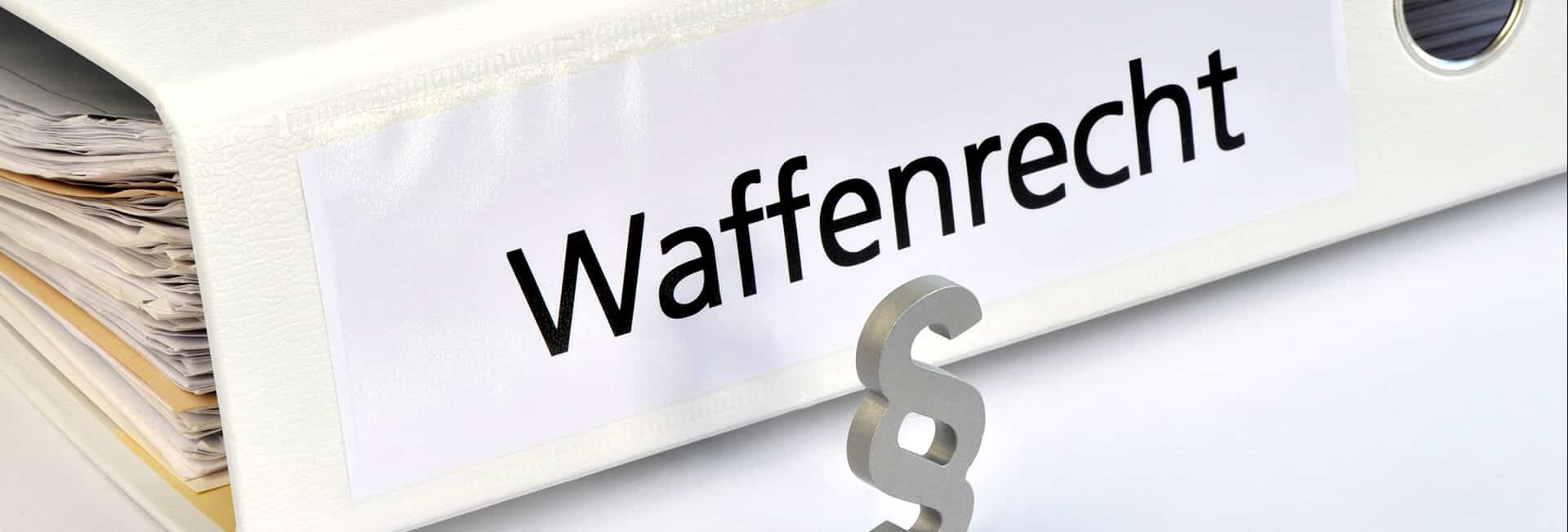The weapon law for knives - what is allowed?
Knives can be tools as well as dangerous stabbing weapons. A knife, which normally only serves as a tool, for example a kitchenknife, can also be quickly alienated as a weapon. For this reason, the Weapons Act divides knives into three main categories: total prohibition of possession, prohibition of use and freely permitted knives.
In principle, all knives sold by us within Germany are permitted under the German Weapons Act. All of the knives we offer here are legal to buy, sell and own. However, the use of fixed knives with a blade length of more than 12 centimeters is regulated by the statutory Weapons Act, including cut and thrust weapons and knives that can be locked with one hand. Transport in a locked container is not classified as carrying.

Total prohibition of possession
The knives under the Prohibition of possession traps may neither be owned nor operated in Germany. In the event of a violation, this falls under the rule of illegal gun possession and is punished accordingly.
The butterfly knife is one of the knives that are banned in Germany. It's a balisong-Knife colloquially known as a butterfly knife. It consists of a two-part, swiveling handle. This makes it possible to use it with just one hand and it is immediately ready for use with a swivel. In Germany it is neither allowed to own this knife nor to carry it with you.
According to the Firearms Act, possession of “fall knives” banned in Germany. A gravity knife is a knife in which the blade comes out of the handle and locks with the help of gravity or a slinging motion. Exceptions for the possession of gravity knives apply to the police, customs administration, the armed forces and other authorities. Some case knives fulfill certain characteristics for rescue knives. They are also classified as such by the authorities and can therefore also be owned. If you are unsure whether you can buy a gravity knife, you can ask the BKA and get advice.
Fist knives are knives where the blade is attached at a 90° angle to the handle. The blade protrudes through this handling between middle and ring finger or index and middle finger and is often used for stabbing. Originally, hunters used fist knives to cut up prey. Since these knives have been misused far too often, possession has been banned in Germany since 2004. Exceptions apply to hunters and fur processors, on condition that possession and use take place within the framework of professional practice.
Seit dem 31. Oktober 2024 ist der Besitz und Umgang mit Springmessern aller Art in Deutschland generell verboten. Switchblade sind Messer bei denen die Klinge mit einem Mechanismus frontal aus dem Heft herausspringt. Je nach Qualität des Springmessers ist der Mechanismus anfälliger für Defekte und Schmutz. Ausnahmen gelten für Personen, die ein berechtigtes Interesse an der einhändigen Führung haben, z.B. aufgrund körperlicher Einschränkungen oder im Zusammenhang mit bestimmten Berufsausübungen wie Jagd oder Handwerk.
Any knife that doesn't look like a knife but looks like some other object is illegal. This includes knives that look like a fountain pen, for example. Also, blades that are hidden in belts or walking sticks may not be possessed. A knife must always be recognizable as such.
In conclusion to the ban on possession of knives in Germany, it can be said that minors are not allowed to acquire any form of knives. Even if these knives are generally allowed, the buyer and owner must be of legal age.

Ban on leadership
The ban on leadership according to the weapon law prohibits certain knives from being carried in public. Knife, which after the weapon law are prohibited from possession, may not be worn in public.
"One-hand locking" knives are knives that have a one-hand opening mechanism and a blade lock. If a knife only has one of these characteristics, it is not affected by § 42a.
According to the weapon law not be carried in public. This also includes, for example, most kitchen knives.
For all of these objects (fixed knives with a blade length of more than 12 centimetres, knives that can be locked with one hand and cutting or thrusting weapons), the legislator only allows them to be carried if there is a legitimate interest. This legitimate interest is defined as leading “in connection with sport, the practice of a profession, the maintenance of customs or a generally recognized purpose”.
Special Ban on leadership in the Gun prohibition zones according to the new law
Die letzte Änderung des Waffengesetzes ist am 31.10.2024 in Kraft getreten. Nachdem zuerst die Rede von einem absolutem Waffenverbot war, wurde nach starken Protesten davon abgesehen. Unter anderem, weil in vielen Berufen die Notwendigkeit besteht, ein Messer mit sich zu führen, da es für die Ausübung der Tätigkeit unabdingbar ist. Dadurch würde es allerdings gegen das geplante Gesetz verstoßen. So wurde die Idee von einem Totalverbot wieder verworfen und das Gesetz überarbeitet. Die Neuerungen beinhalten neue Vorschriften für Gun Prohibition Zones, in which a separate weapon law applies. Also was in the old weapon law there was talk of exceptions to the use of weapons. However, these were only described very imprecisely. The new weapons law has now specifically defined these exceptions. So you can refer explicitly to the law and are no longer exposed to the arbitrariness of the person responsible.
What exactly is it now allowed in the Gun Prohibition Zones?
Waffenverbotszonen sind Gebiete wie Schulen oder öffentliche Plätze wie Bahnhöfe. Die Landesregierungen können nun durch Rechtsverordnung das Führen von Messern in diesen Gebieten verbieten oder einschränken. In diesen Waffenverbotszonen können Personen jederzeit kontrolliert werden. Die Regelungen und Ausnahmen für das Führen von Messern innerhalb einer Waffenverbotszone können regional unterschiedlich sein. Erlaubt sind in der Regel nur Messer mit einer Klingenlänge von weniger als 4 cm sowie Taschenmesser ohne feststellbare Klinge. Ein Beispiel hierfür ist das Schweizer Taschenmesser. Alle Messer, die diese Anforderungen nicht erfüllen, dürfen in einer Waffenverbotszone nicht mitgeführt werden.
Exceptions for guiding knives in the Gun prohibition zones
Holders of a weapons license may also be in a Gun prohibition zone Carry a knife with you. This means that holders of a gun license, a small gun license and a gun ownership card are allowed to carry a knife with them without a justified interest. The only requirement for this permit is to carry the certificate and a valid photo ID.
local residents, Residents or delivery traffic in the Gun prohibition zone
Residents are people who are legally resident in the Gun prohibition zone to have. It also includes people who are in the Gun prohibition zone have a special concern to fulfill. This concern can be visiting a friend, a shoe store, or simply the park bench. The interpretation of the word “concern” is therefore very broad. This exemption for residents and residents allows almost everyone to carry knives with a blade length of up to 12 cm in the Gun prohibition zone.
People who need a knife to carry out their job can continue to carry it with them. This regulation also includes their employees.
In the old weapon law was an often described exception, the practice of a custom or a certain sport. This is also in the revised version of the Arms Act still noted. Hunters are allowed to carry their knife with them when they practice their sport. Even anglers or sailors don't have to be afraid to bring their knife just because they want to practice their sport in one Gun prohibition zone exercise. The idea behind this exception was that old traditional festivals in particular should not be affected by the law.
Transferring knives from one place to another without direct access is also in one Gun prohibition zone allowed. This includes, for example, buying one Hunting knife outside the zone and transporting the knife in the packaging through the Gun prohibition zone. However, the words "direct access" are not very well defined and leave a lot of room for interpretation.
Every homeowner has their own domestic rights and, within the meaning of this right, carrying a knife is permitted within the scope of domestic rights if the carrying of the knife serves the purpose of staying.
Verbot des Mitführens von Messern in öffentlichen Fernverkehrsmitteln
Der neu eingeführte § 42b des Waffengesetzes verbietet das Führen von Messern in Fahrzeugen des öffentlichen Personenfernverkehrs einschließlich der dazugehörigen Gebäude und Haltestellen, soweit diese seitlich umschlossen sind. Die oben genannten Ausnahmen gelten auch hier, so dass das Mitführen ohne Zugriffsmöglichkeit weiterhin erlaubt ist.
Conclusion on the weapon law
The prohibition of possession of knives is very precise weapon law geregelt, lediglich das Tragen in der Öffentlichkeit lässt etwas Spielraum zu. Mit der neuen Gesetzesänderung vom 31.10.2024 kamen zusätzlich neue Vorschriften für Gun prohibition zones hinzu sowie der § 42b, der das Mitführen von Messern in öffentlichen Fernverkehrsmitteln regelt.
Here's a quick overview of that weapon law and its exceptions:
Prohibition of possession and thus also illegal gun possession applies to:
- Butterfly knife or Balisong knife
- Drop knife
- Fist knife
- Switchblade
- All knives that pretend to be something else or are hidden, e.g. blade in a belt
- All forms of knives if the buyer / owner is a minor
Exceptions
- Drop knives may be owned by the armed forces, customs authorities and the police
- Fist knives may be owned by hunters and fur processors in order to carry out their work
Ban on leadership
These knives may be owned but not used in public
- Knife with a blade that can be locked with one hand (one-hand knife)
- Knives with a blade length of more than 12 cm
Special Ban on leadership in the Gun prohibition zones
- Knives with a blade length of more than 4 cm
Permitted leadership in the Gun prohibition zone
- Messer mit einer Klingenlänge von weniger als 4 cm (kann regional unterschiedlich sein)
- Pocket knife without a lockable blade, e.g. Swiss Army Knife
Exceptions for guiding knives in the Gun prohibition zone
- For holders of a gun license
- For residents, residents and delivery traffic within the gun ban zone
- People who need the knife to do their job
- People who carry the knife to practice a tradition or sport
- The inaccessible transfer of knives
- The use of a knife in the domiciliary area, if the use serves the purpose of the stay
Legal situation in other countries
Of course, different legal framework conditions apply in other countries in Europe and the world. For deliveries to buyers outside of Germany, other country-specific restrictions or bans on certain items may therefore apply. The buyer is responsible for ensuring that the import and possession of the items he has ordered do not violate the legal provisions of his home country. Unfortunately, we cannot know, explain and interpret all of the large number of different laws in different countries.
legal advice
We would also like to point out that this summary is for non-binding information purposes only and does not constitute legal advice in the strict sense. Individual and binding legal advice that addresses your specific situation cannot and should not replace it. All information provided is therefore without guarantee of correctness and completeness.
Für weitere Informationen und detaillierte Ausführungen empfehlen wir, die offiziellen Gesetzestexte zu konsultieren oder rechtlichen Rat einzuholen.







